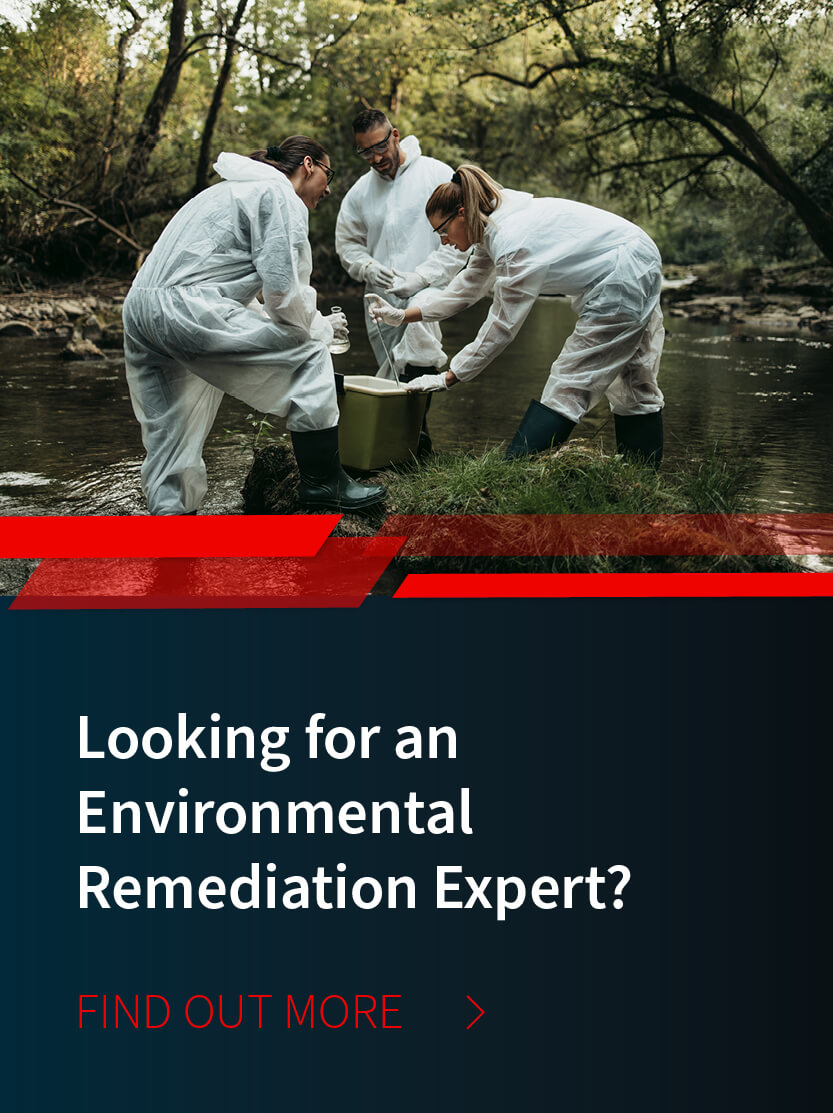
/ IN THIS BLOG
01 / Introduction
In matters of hazardous waste disposal, there are at least three contexts in which to consider site cleanup.
First, remember that too much of anything can require hazardous waste disposal—no matter how environmentally benign it might seem. For example, even milk can require environmental remediation, if it accidentally gets dumped someplace it isn’t supposed to be. How so?
While pouring milk into the environment might seem harmless at first blush, a slick made of milkfat will block oxygen and sunlight just as effectively as one made of petroleum, ecologically devastating nearby waterways.
Second, there’s the unlucky circumstance wherein you’ve been innocently disposing of a waste that’s relatively unregulated by the EPA, but then learn that state environmental rules deem it a more egregious pollutant that requires site cleanup. California comes to mind:
Back in 2007, that state enacted a statewide chemistry policy that exceeds the scope of the federal Toxic Substances Control Act (TSCA). And local governments (e.g. San Francisco) also tightened environmental controls. This is not unusual, as state & local environmental regulations are commonly stricter than their federal counterparts.
Third, there’s the ubiquitous circumstance where a known environmental pollutant has been accumulating known or unknown somewhere, but now needs to be removed, usually because the site-owner wants to use the property for something else.
On a small scale, out-of-business gas stations are a good example of this, where leaky storage tanks have let gasoline leach into the soil, unknown. So are defunct shooting ranges, where spent lead has accumulated into earthen ammo-backstops, known. And there are former dry‑cleaning establishments, which used tetrachloroethylene, a Group 2A carcinogen.
On a larger scale, there are so-called brownfield sites: industrial-size abandoned, idled, or underused properties wherein redevelopment is hindered by environmental contamination. Typical among these are defunct railroads yards, oil refineries, steel plants, liquid/chemical storage facilities, and heavy manufacturing facilities.
Note: The EPA maintains a Brownfields Program to provide funds and technical assistance to states, communities, and other economic stakeholders to assess, clean up, and sustainably reuse brownfields. Contact us to find out more.
02 / Environmental remediation
In all three of these circumstances, whether you’ve determined by yourself that you have property requiring site cleanup; or some local, state, or federal authority tells you likewise; the onus is on you to get the job done—legally.
This is what the EPA calls “environmental remediation,” which involves removing contaminants from soil, groundwater, sediments, surface water, etc.But you just can’t go out with a shovel & wheelbarrow and start digging up contaminants—neither literally nor metaphorically.
To begin, environmental remediation per the EPA is subject to a host of general regulations, no surprise. But in cases where applicable laws are either nonexistent or advisory, your situation might evoke ad hoc requirements based on presumed risks, hitherto unconsidered.
As in all things regarding the EPA, it’s crucial to get expert advice.
03 / Site cleanup assessment & methods
If you have a property that requires site-cleanup, it will need an environmental risk assessment to determine exactly what kind of pollution it contains. I.e., the size, type, and extent of contamination; the media affected; and the local environmental & geological characteristics.
Minimally, this demands soil sampling, chemical analysis, and other hard science that should only be conducted by personnel qualified to do so
Again— it is crucial to consult an environmental remediation expert before proceeding.
As to the actual site cleanup, there are two approaches.
Ex-situ methods involve extracting the contaminated soil and groundwater, and then hauling it offsite to an appropriate treatment facility. As you’re legally responsible for all hazardous waste from waste cradle-to-grave, you’ll want to make sure that the company you hire is current on DOT hazmat transportation requirements.
In-situ methods treat the soil and groundwater without removal. They involve such technologies as “soil vapor or steam-enhanced extraction,” “chemical oxidation,” “bioremediation‑phytoremediation,” “thermal desorption,” and other chemical interventions.
04 / EPA site cleanup supervision & involvement
Per the RCRA, the EPA supervises the scientific examination of a property needing environmental remediation (e.g. soil sampling, chemical analysis, etc.). The site cleanup itself might be performed by the EPA, other federal agencies, states, or local municipalities.
But in many cases, the party responsible for the contamination is charged with conducting the site cleanup. If that’s you, then remember that the company you engage to assist you will have to be duly “licensed & permitted” per the EPA—as well as by any number of state & local bureaucracies.
05 / Get expert consultation
Given the degree of attention the EPA dedicates to environmental site cleanup, it’s imperative that you work with a hazardous waste disposal company that’s expert in—and specifically licensed for—environmental remediation.
Thereby you’ll be assured that your environmental-remediation efforts are compliant with all EPA regulations and mandates—as well as any ad hoc requirements based on presumed risks, previously unconsidered. More specifically:
For ex-situ tactics, look for documented, fully-compliant experience in the hauling and/or disposing of contaminated soil and groundwater.
For in-situ tactics, look for a documented history of sound scientific practice.
Remember, one of the imperatives of the RCRA is that you’re responsible for any hazardous waste from “cradle-to-grave.” This includes its generation, transportation, treatment, storage, and disposal.
Thereby, you’re not only accountable for a hazardous waste from the moment it’s generated; you’re also legally responsible for its safe transportation to wherever it will be ultimately processed or disposed of.
A non-compliant site cleanup effort can generate more legal, regulatory, and environmental complications than it solves. Don’t take chances. Through our use of innovative technologies and solutions, MCF provides a wide array of services to address the most challenging of site‑cleanup projects.
Such services include specialized remediation tactics, as well as expert consultation about regulatory strategies across a wide breadth of media, including contaminated soils, sediments, and groundwater. Visit our environmental services page here to learn more about our site remediation specialization.
Get expert advice today. And thank you for reading our blog!
Robert Losurdo
President, COO








